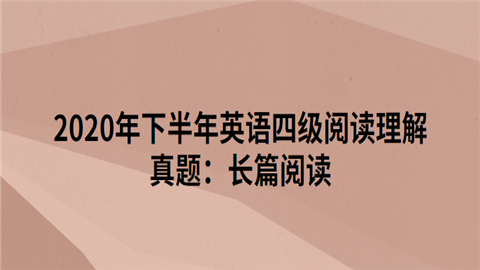2020年下半年英语四级阅读理解真题:长篇阅读
【导读】2020年下半年全国大学英语四、六级考试已经于12月12日结束。考后大家最为关心的就是本次考试真题及答案,小编为大家跟进四、六级真题及答案,为大家整理了2020年下半年英语四级阅读理解真题:长篇阅读,希望可以帮助已考试的考生进行自我估分,打算下次报考的考生可以提前模拟。

Section B
Directions: In this section, you are going to read a passage with ten statements attached to it. Each statement contains information given in one of the paragraphs. Identify the paragraph from which the information is derived. You may choose a paragraph more than once. Each paragraph is marked with a letter. Answer the questions by marking the corresponding letter on Answer Sheet 2.
Poverty is a story about us, not them
[A] Too often still, we think we know what poverty looks like. It’s the way we’ve been taught, the images we’ve been force-fed for decades. The chronically homeless. The undocumented immigrant. The urban poor, usually personified as a woman of color, the “welfare queen” politicians still too often reference.
[B] But as income inequality rises to record levels in the United States, even in the midst of a record economic expansion, those familiar images are outdated, hurtful, and counterproductive to focusing attention on solutions and building ladders of opportunity.
[C] Today’s faces of income inequality and lack of opportunity look like all of us. It’s Anna Landre, a disabled Georgetown University student fighting to keep health benefits that allow her the freedom to live her life. It’s Tiffanie Standard, a mentor for young women of color in Philadelphia who want to be tech entrepreneurs – but who must work multiple jobs to stay afloat. It’s Sharon Penner, an artisan in rural Georgia, who worries about retirement security and health care options for senior gay women. It’s Charles Oldstein, a U.S. Air Force veteran in New Orleans who would still be on the street if the city hadn’t landed a zero tolerance policy for homeless among veterans. It’s Ken Outlaw, a welder in rural North Carolina whose dream of going back to school at a local community college was dashed by Hurricane Florence –just one of the extreme weather events that have tipped the balance for struggling Americans across the nation.
[D] If these are the central characters of our story about poverty, what layers of perceptions, myths, and realities must we unearth to find meaningful solutions and support? In pursuit of revealing this complicated reality, Mothering Justice, led by women of color, went last year to the state capital in Lansing, Michigan, to lobby on issues that affect working mothers. One of the Mothering Justice organizers went to the office of a state representative to talk about the lack of affordable childcare—the vestiges of a system that expected mothers to stay home with their children while their husbands worked. A legislative staffer dismissed the activist’s concerns, telling her “my husband took care of that—I stayed home.”
[E] That comment, says Atkinson, “was meant to shame” and relied on the familiar trope that a woman of color concerned about income inequality and programs that promote mobility must by definition be a single mom, probably with multiple kids. In this case, Mothering Justice activist happened to be married. And in most cases in the America of 2019, the images that come to mind when we hear the words poverty of income inequality fail miserably in reflecting a complicated reality: poverty touches virtually all of us. The face of income inequality, for all but a very few of us, is the one we each see in the mirror.
[F] How many of us are poor in the U.S.? It depends on who you ask. According to the Census Bureau, 38 million people in the U.S. are living below the official poverty thresholds (currently $20,231 for a family of three with two children). Taking into account economic need beyond that absolute measure, the Institute for Policy Studies found that 140 million people are poor or low-income, living below 200 percent of the Census’ supplemental measure of poverty. That’s almost half the U.S. population.
[G] No matter the measure, within that massive group, poverty is extremely diverse. We know that some people are more affected than others like children, the elderly, people live with disabilities, and people of color.
[H] But the fact that 4 in 10 Americans can’t come up with $400 in an emergency is a commonly cited statistic for good reason: economic instability stretches across race, gender, and geography. It even reaches into the middle classes, as real wages have stagnated for all but the very wealthy and temporary spells of financial instability are not uncommon.
[I] Negative caricatures remain of who is living in poverty as well as what is needed to move out of it. The iconic American myth is that you can pull yourself up by your bootstraps and change a bad situation into a good one. The reality is that finding opportunity without help from families, friends, schools, and community is virtually impossible. And the playing field is nothing close to level.
[J] The FrameWorks Institute, a research group that focuses on public framing of issues, has studies what props up stereotypes and narratives of poverty in the United Kingdom. “People view economic success and wellbeing in life as … a product of choice, willpower, drive, grit, and gumption,” says NatKendall-Taylor, CEO of FrameWorks. “When we see people who are struggling,” he says, those assumptions “lead us to the perception that people in poverty are lazy, they don’t care, and they haven’t made the right decisions.”
[K] Does this sound familiar? Similar ideas surround poverty in the U.S. And these assumptions wreak havoc on reality. “When people enter into that pattern of thinking,” says Kendal-Taylor, “it’s cognitively comfortable to make sense of issues of poverty in that way. It creates a kind of cognitive blindness –all of the factors external to a person’s drive and choices that they’ve made become invisible and fade from view.”
[L] Those external factors include the difficulties concomitant with low-wage work or structural discrimination based on race, gender, or ability. Assumption get worse when people who are poor use government benefits to help them survive. There is a great tension between “the poor” and those who are receiving what has become a dirty word: “welfare.”
[M] According to the General Social Survey, 71 percent of respondents believe the country is spending too little on “assistance to the poor.” On the other hand, 22 percent think we are spending too little on “welfare”; 37 percent believe we are spending too much.
[N] “Poverty has been interchangeable with people of color—but specifically black women and black mothers,” says Atkinson of Mothering Justice. It’s true that black mothers are more affected by poverty than many other groups, yet they are disproportionately the face of poverty. For example, Americans routinely overestimate the share of black recipients of public assistance programs.
[O] In reality, most people will experience some form of financial hardship at some point in their lives. Indeed, people tend to dip in and out of poverty, perhaps due to unexpected obstacles like losing a job, or when hours of a low-wage job fluctuate.
[P] Something each of us can do is to treat each other with the dignity and compassion that is deserved and to understand deeply that the issue of poverty touches all of us.
36. One legislative staffer assumed that a woman of color who advocated affordable childcare must by a single mother.
37. People from different races, genders, and regions all suffer from a lack of financial security.
38. According to a survey, while the majority believe too little assistance given to the poor, more than a third believe too much is spent on welfare.
39. A research group has found that Americans who are struggling are thought to be lazy as they have made the wrong decision.
40. Under the old system in American, a mother was supposed to stay home and take care of her children.
41. …found that nearly 50% of Americans are poor or receive low pay.
42. Americans usually overestimate the number of blacks receiving welfare benefits.
43. It is impossible for Americans to lift themselves out of poverty entirely on their own.
44. Nowadays, it seems none of us can get away from income inequality.
45. Assumptions about poor people become even more negative when they live on welfare.
【答案】
36. E 37. H 38. M 39. J 40. D 41. F 42. N 43. I 44. C 45. L
2020年下半年英语四级阅读理解真题:长篇阅读小编就说到这了。更多关于大学英语四级考试的备考技巧,备考干货,新闻资讯,成绩查询,准考证打印入口,准考证打印时间等内容,小编会持续更新。祝愿各位考生都能认真备考,顺利通过考试。
-
2016年7月公布的AFP试题——金融理财基础(二)下 载577272 下载数 106
-
2016年7月公布的AFP试题——金融理财基础(一)下 载596131 下载数 99
-
2022年AFP证书复习考试学习资料下 载1121040 下载数 124
-
2022年AFP考试考前资料准备下 载196140 下载数 60
外语少儿相关文章推荐
|外语少儿最新文章推荐
|外语少儿最新经验推荐
- 2026国家公务员报名入口全解析:一键直达,轻松报考!
- 2026国家公务员考试时间全解析!考生必看指南
- 2026国考时间敲定!备考冲刺计划启动
- 2026国家公务员报考时间安排一览表
- 教师资格每年考几次?
- 2026年教师资格什么时间考试?
- 2025下半年陕西事业单位教师岗成绩查询:时间定了?入口+复审攻略速存!
- 2025下半年陕西事业单位教师岗成绩什么时间发布?
- 从报名到拿证!普通人考取2025年12月公共营养师证书全指南
- 2025年12月公共营养师报名有限制吗?高中学历能不能报?
-

环球网校
15:00-18:00 15:00-18:00 10月21日 15:00-18:00
一建双11早鸟福利,免单+红包雨不断
一级建造师
-

环球网校
15:00-18:00 15:00-18:00 10月22日 15:00-18:00
一建双11特惠攻略,现在买不吃亏
一级建造师
-

知心助教-洋洋
19:00-21:00 19:00-21:00 10月23日 19:00-21:00
双11超级攻略夜・爆品1元秒杀+千元红包狂撒
公司活动
-

环球网校
15:00-18:00 15:00-18:00 10月24日 15:00-18:00
一建这样答题多拿十几分,直播揭秘得分技巧
一级建造师
-

张君
19:00-20:30 19:00-20:30 10月24日 19:00-20:30
一造转一建·双11备考福利会
一级建造师
-
2016年7月公布的AFP试题——金融理财基础(二) 577272下载数 106 下 载
-
2016年7月公布的AFP试题——金融理财基础(一) 596131下载数 99 下 载
-
2022年AFP证书复习考试学习资料 1121040下载数 124 下 载
-
2022年AFP考试考前资料准备 196140下载数 60 下 载
- 01 北京大约多久能解除疫情?
- 02 《中华人民共和国车船税法》全文
- 03 医师级别划分 十二级
- 04 这几种情况千万不要考消防工程师证书
- 05 2020年开年全球大事件你知道吗?
- 06 公务员存在不同级别 一级科员和一级行政执法员区别在哪
- 07 博士,硕士,研究生哪个学历高
- 08 中级资格证书有哪些
- 09 成人高考和自考有什么区别
